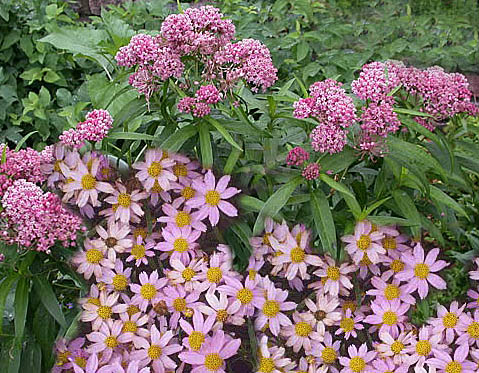 Moist spots in the garden can be difficult to plant but this combination for a pink sunny border may be just the answer. With a mass of pink daisy-like flowers over a long bloom season, the pink tickseed provides color from June to September with the milkweed joining in during July and August. The small flowers of the milkweed are produced in large clusters, are deep pink in bud but turn lighter as they open. The flowers of the tickseed are larger, a more uniform pink, and echo milkweed flowers in color but contrast them in size and texture. The swamp milkweed can tolerate wet soil but the tickseed needs decent drainage, and can’t tolerate drying out.
Moist spots in the garden can be difficult to plant but this combination for a pink sunny border may be just the answer. With a mass of pink daisy-like flowers over a long bloom season, the pink tickseed provides color from June to September with the milkweed joining in during July and August. The small flowers of the milkweed are produced in large clusters, are deep pink in bud but turn lighter as they open. The flowers of the tickseed are larger, a more uniform pink, and echo milkweed flowers in color but contrast them in size and texture. The swamp milkweed can tolerate wet soil but the tickseed needs decent drainage, and can’t tolerate drying out.
 Swamp Milkweed (Aslepias incarnata)
Swamp Milkweed (Aslepias incarnata)
A native to the wet lands of many parts of the Unitede States, this herbaceious perennial is attractive to butterflies as well as to hummingbirds and bees. Their fragrant pink to mauve flowers are borne in dense clusters (umbels) and give way to attractive 4” long seed pods that persist into winter. The seeds have long silky hairs that facilitate wind dissemination. The stems contain a toxic sticky sap.
-
Bloom Time: July to August
Size: 4-5’ H x 2-3’ W
Hardiness: Zones 3-6
 Pink Tickseed (Coreopsis rosea)
Pink Tickseed (Coreopsis rosea)
Native to the sandy soils along the eastern coast of North America from Nova Scotia to Maryland, pink tickseed is an easily grown perennial that forms a dense clump and provides masses of pink flowers above finely dissected foliage. Bloom time can be lengthened by shearing off the flowers in mid-summer. Pink tickseed spreads rapidly by rhizomes and seeds and can become aggressive and even invasive if the location to its liking.
-
Bloom Time: June-September
Size: 12-24” H x 18-30” W
Hardiness: Zones 3-6
